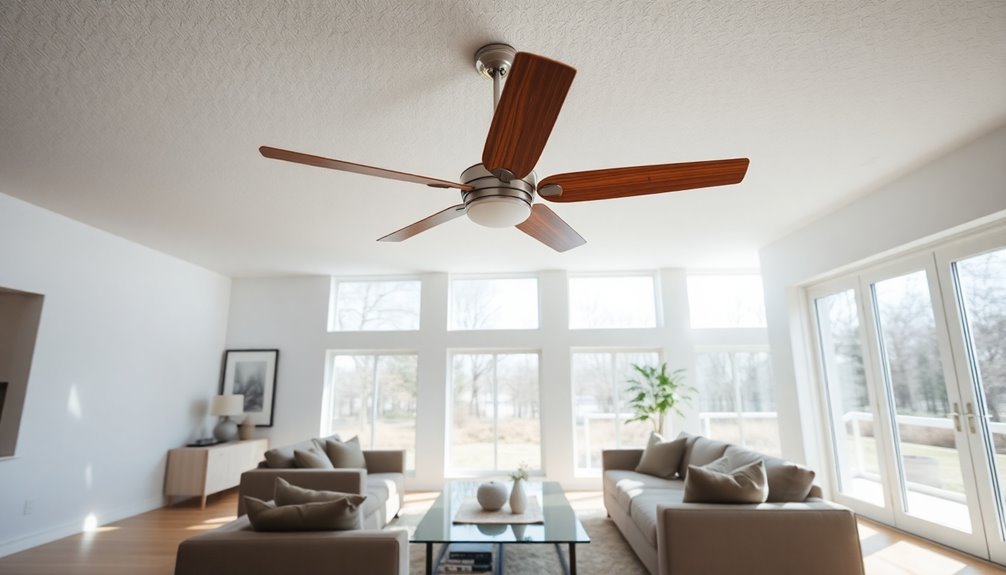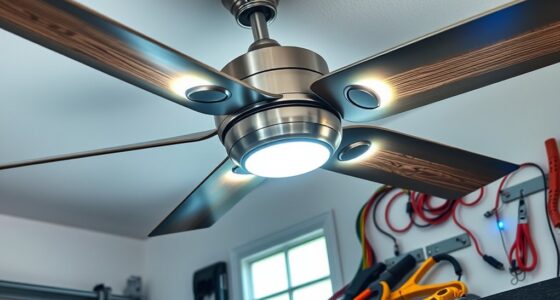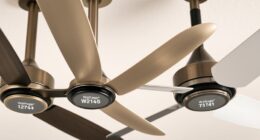Ceiling fans come in a variety of sizes to suit different room dimensions. For small rooms up to 75 sq. ft., you'll want fans between 29-36 inches. Medium rooms fit well with 42-48 inch fans, while standard rooms typically use 52 inch models. For large spaces over 225 sq. ft., a 60 inch fan is perfect. For extra-large areas, fans with a blade span of over 60 inches work best. Choosing the right size guarantees ideal airflow and comfort. Keep exploring to discover how to match fans with your space for maximum efficiency and style.
Key Takeaways
- Ceiling fans range in size from 12 inches to over 96 inches, accommodating various room dimensions and airflow requirements.
- Small fans (29-36 inches) are suitable for spaces up to 75 sq. ft., ideal for small rooms.
- Medium fans (42-48 inches) work well for areas up to 144 sq. ft., making them perfect for living rooms or bedrooms.
- Standard 52-inch fans are recommended for typical room sizes of 12×12 to 18×18 ft.
- For large rooms over 225 sq. ft., 60-inch fans or larger are necessary to ensure adequate airflow.
Popular Fan Sizes
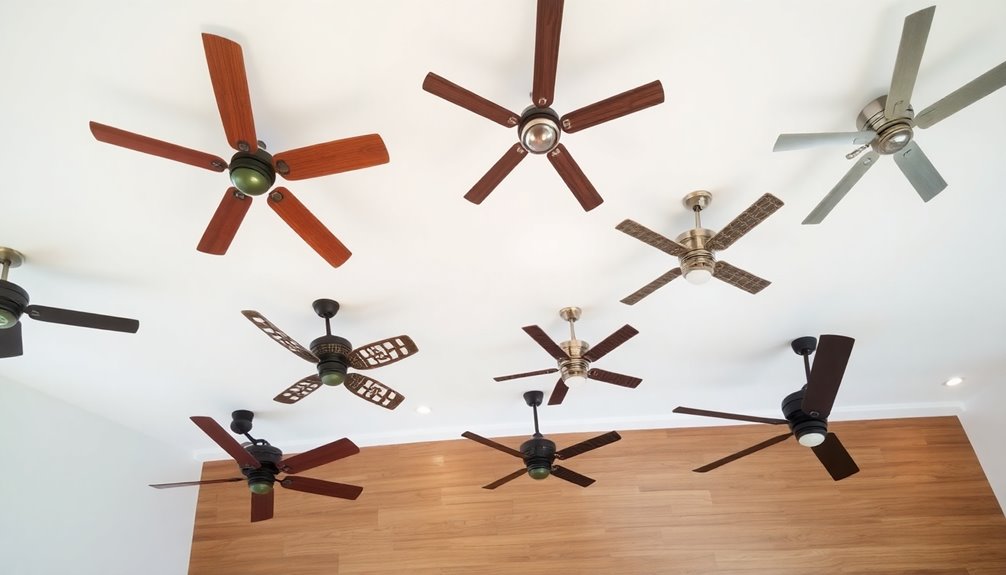
When it comes to choosing the right ceiling fan size, it's essential to match the fan to your room's dimensions for ideal airflow. Ceiling fan sizes vary considerably, so knowing which one works best for you can enhance comfort in your space.
For large rooms or outdoor areas, a 60-inch fan is typically the best choice, providing ample airflow. If your room measures between 12×12 and 18×18 feet, a 52-inch fan is a great option, as it's designed for standard rooms.
For smaller spaces, you'll want to evaluate fans with a blade span of 29-36 inches, which works well in rooms up to 75 square feet. If your area is a bit larger, a fan with a 36-44 inch blade span is suitable for spaces up to 144 square feet.
Keep in mind that for rooms exceeding 225 square feet, fans with a blade span of 44 inches or more are recommended. Remember, ceiling fans can range from 12 inches to 96 inches, so there's a perfect fit for every room and ceiling height.
Understanding Airflow
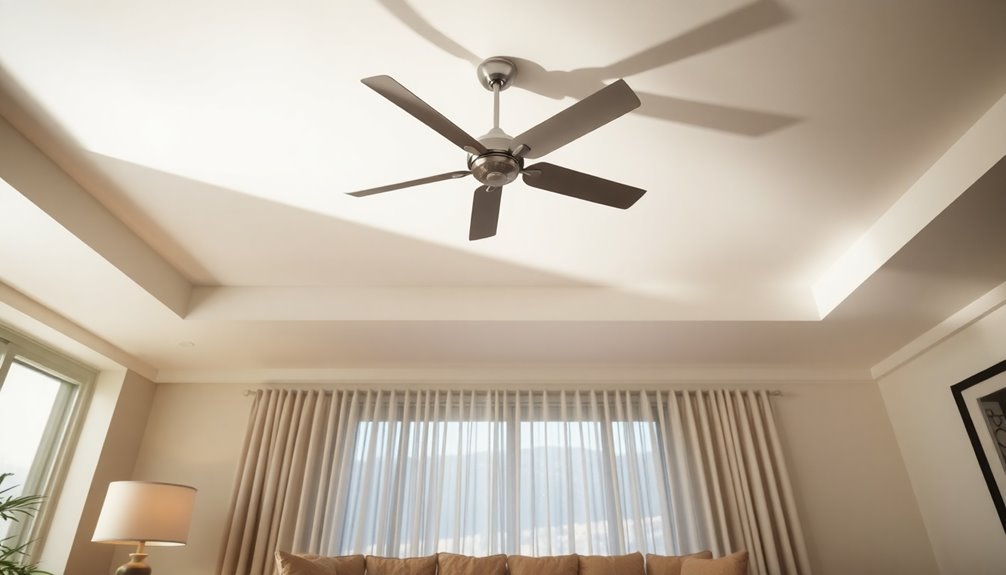
Choosing the right ceiling fan size directly impacts airflow in your space. The fan's blade span plays an essential role in determining airflow efficiency, measured in CFM (cubic feet per minute). Larger blade spans generally provide better air movement, which is vital for keeping your room comfortable.
Here's a quick overview of how different blade spans affect airflow:
| Blade Span (inches) | Room Size (square feet) | CFM Rating |
|---|---|---|
| 12-24 | Up to 75 | 200-400 |
| 29-36 | Up to 75 | 400-700 |
| 42-52 | 75-144 | 700-1,500 |
| 56-96 | 144+ | 1,500+ |
For ideal cooling, you need to choose a fan that fits your room size. Using a fan with a blade span that's too small can lead to poor airflow and discomfort. Additionally, a fan with a higher blade pitch can enhance cooling by effectively moving air at lower speeds. So, make sure to take into account both blade span and CFM when selecting your ceiling fan!
Choosing the Right Size
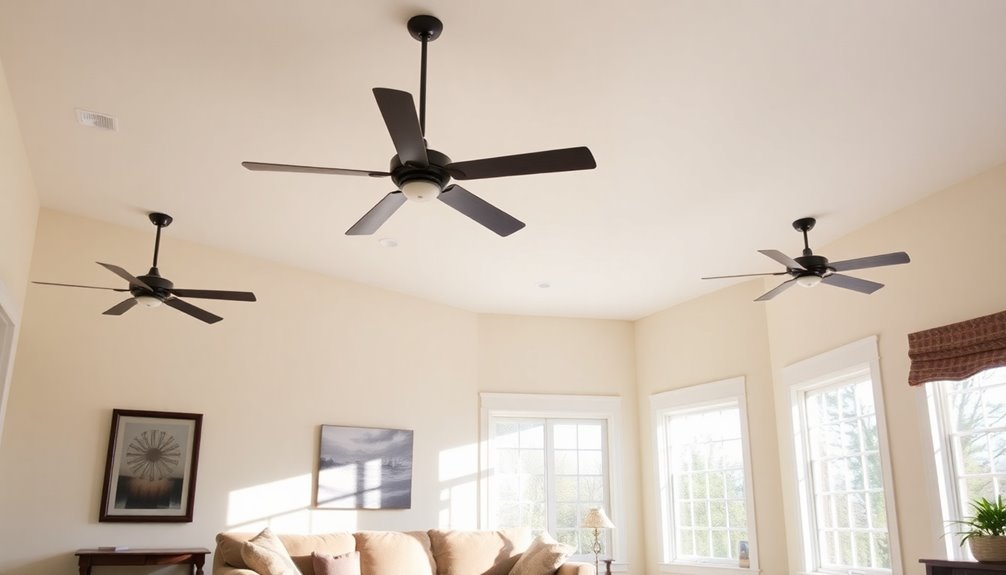
Selecting the right ceiling fan size is essential for ensuring ideal air circulation in your space. When you're choosing the right size, start by measuring your room dimensions.
For rooms up to 75 square feet, a ceiling fan size of 29-36 inches is recommended. If your room is larger, up to 400 square feet, you'll need a fan that spans between 50 and 71 inches for maximum airflow.
For average rooms, typically measuring 12×12 to 18×18 feet, a 52-inch fan is often the best choice. This size strikes a balance, providing effective air circulation without overwhelming the space.
Don't forget to take into account your ceiling height, too. If your ceiling is over 8 feet, downrods can help position the fan correctly, ensuring you get the best airflow possible.
Ceiling Fan Height Considerations
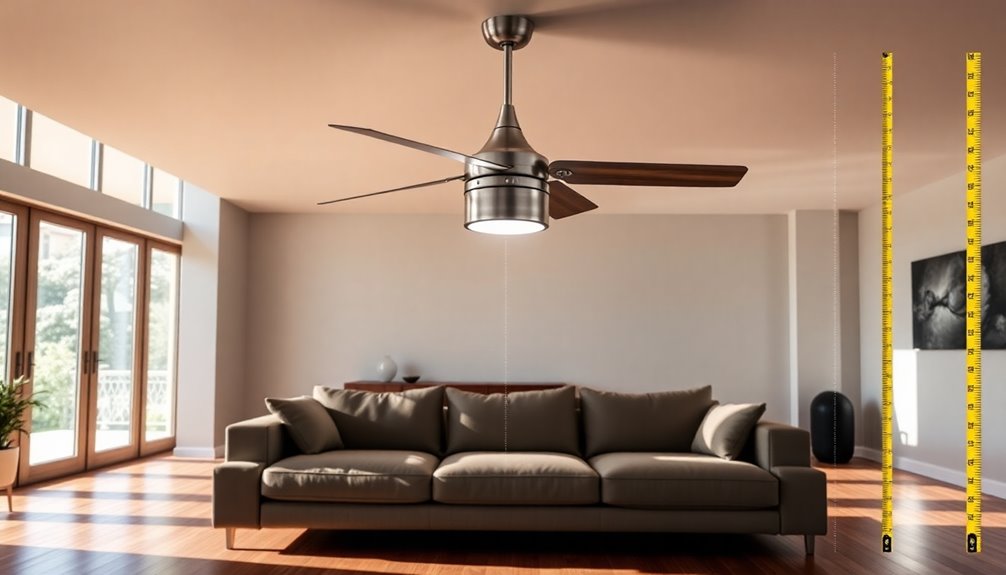
Hanging your ceiling fan at the correct height is vital for both safety and effective airflow. Ideally, you should install your fan at least 7 feet above the floor. For ceilings higher than 8 feet, consider using a downrod to lower the fan to a desirable height of 8 to 9 feet. This height allows the fan blades to circulate air effectively.
When positioning your ceiling fan, remember to maintain a minimum clearance of 12 inches from walls. This space is important for guaranteeing proper airflow and preventing any obstructions.
If your ceiling height is low, flush mount fans can be a great choice, as they sit closer to the ceiling, providing a stylish solution without compromising safety.
For higher ceilings, a downrod mount is preferred, as it enhances air movement by bringing the fan closer to the living space. Additionally, make sure there's at least 18 inches of clearance between the fan blades and the nearest wall to guarantee safe and efficient operation. Regular maintenance, including checking for mechanical failure, can help ensure the ceiling fan operates safely and effectively.
Blade Span by Room Size
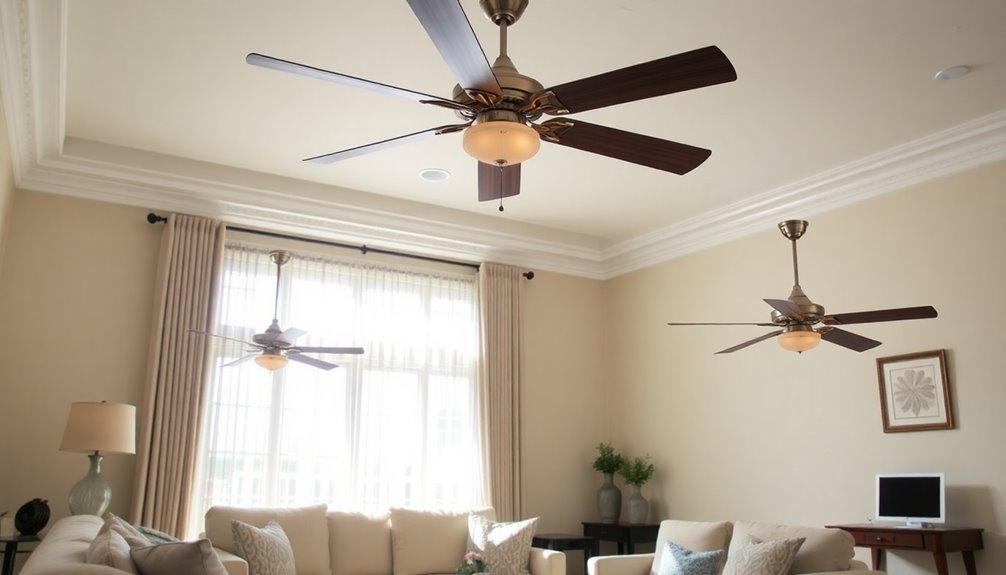
Understanding the right blade span for your ceiling fan is essential to achieving ideal airflow in your space. Choosing the correct size based on your room size will enhance air circulation and comfort.
Here's a quick guide to help you decide:
- Small Rooms (up to 75 sq. ft.): Opt for a fan with a blade span of 29 to 36 inches. This size efficiently circulates air without overwhelming the space.
- Medium Rooms (75 to 175 sq. ft.): A blade span of 42 to 48 inches is ideal. This guarantees effective air circulation, making your room feel more comfortable.
- Large Rooms (175 to 350 sq. ft.): For these spaces, choose a fan with a blade span of 52 to 56 inches. It'll maintain adequate airflow and keep the environment pleasant.
For extra-large areas exceeding 350 square feet, a fan with a blade span of 60 inches or wider is advisable to properly circulate air throughout the room.
Motor Types and Efficiency

When it comes to ceiling fans, choosing the right motor type can make a noticeable difference in your home's energy efficiency and comfort. You typically have two options: AC motors and DC motors. While AC motors are common and economical, DC motors are becoming increasingly popular due to their superior benefits.
DC motors not only provide faster startup and a wider range of speeds, but they also consume up to 70% less energy than their AC counterparts, which means quieter operation and lower utility bills over time. Plus, if you opt for Energy Star-rated fans, you'll enjoy at least 20% energy savings compared to standard models.
Here's a quick comparison of the two motor types:
| Motor Type | Energy Efficiency | Cost Consideration |
|---|---|---|
| AC | Standard | Lower upfront cost |
| DC | Up to 70% more efficient | Higher upfront cost, savings over time |
Ultimately, the choice of motor type considerably impacts your long-term operational costs. Investing in a DC motor might require a higher initial expenditure, but the energy efficiency benefits can lead to substantial savings down the road.
Installation Tips and Guidelines

When you're ready to install your ceiling fan, make certain you know the proper mounting techniques and ideal hanging height for maximum performance.
It's vital to prioritize electrical safety, so always refer to the instruction manual and consult an electrician if you have any doubts.
Following these guidelines will guarantee your fan operates efficiently and safely.
Proper Mounting Techniques
Properly mounting a ceiling fan is essential for guaranteeing ideal airflow and safety in your space. To achieve this, follow these key techniques:
- Determine the correct downrod length: For ceilings higher than 8 feet, subtract 12 inches from your ceiling height to find the appropriate downrod length. This guarantees your fan is mounted approximately 8 feet above the floor for maximum airflow.
- Choose flush mount options for low ceilings: If your ceiling is low, consider flush mount options. These can be installed directly against the ceiling, typically requiring just 6-10 inches of space above the fan blades.
- Secure the mounting hardware: Before installation, always check that you have a suitable electrical box. Metal boxes are often required for secure mounting of ceiling fans, guaranteeing safety and stability.
Once you've got your mounting hardware ready, follow the manufacturer's installation manual for specific instructions.
This way, you can prevent accidents during installation and enjoy a well-mounted ceiling fan that enhances your living space.
Ideal Hanging Height
The ideal hanging height for a ceiling fan is fundamental to achieving the best airflow and comfort in your space. To guarantee peak performance, aim for a fan height from floor of approximately 8 to 9 feet.
If your ceiling is higher than 8 feet, it's best to use a downrod to lower the fan. This setup assures at least 12 inches of clearance from walls, promoting effective air circulation.
If your ceiling is below 8 feet, consider flush mount fans. These are installed directly against the ceiling, allowing you to maximize space without compromising safety.
Whichever option you choose, maintaining a minimum distance of 18 inches between the fan blades and any walls or obstructions is essential. This distance prevents airflow blockage and assures safety.
When determining the downrod length, simply subtract 12 inches from your total ceiling height. This calculation helps you achieve the ideal fan height for peak performance.
Electrical Safety Considerations
Installing a ceiling fan requires careful attention to electrical safety to guarantee a smooth and secure operation. Here are some essential installation tips to keep in mind:
- Check the Electrical Box: Verify the electrical box is rated to support the weight of your ceiling fan. Metal boxes are generally the safest option for stability.
- Turn Off Power: Before starting your installation, turn off the power at the circuit breaker. This step is vital to prevent electrical shock and guarantee a safe working environment.
- Follow Wiring Guidelines: Use appropriate wire sizes according to the manufacturer's guidelines and local electrical codes. Typically, 14-gauge wire is suitable for fans drawing up to 15 amps.
Always follow the installation manual closely, paying attention to safety warnings and instructions. Additionally, ensure that the ceiling fan is mounted securely to prevent any accidents during operation.
If you're unsure about any electrical connections or the installation process, it's wise to consult a qualified electrician. This guarantees compliance with local electrical codes and maintains safety standards.
With these precautions, you can enjoy your new ceiling fan without any concerns!
Additional Resources and Support

When it comes to choosing the right ceiling fan size, you'll find a wealth of additional resources and support available to guide you. Many manufacturers offer helpful guides tailored to your specific room dimensions and ceiling heights, guaranteeing you select the perfect fan size. For instance, you might consider the recommended blade spans based on your room size:
| Room Size | Recommended Fan Size |
|---|---|
| Small Room | 29-36 inches |
| Medium Room | 42-48 inches |
| Large Room | 52 inches or larger |
| Extra Large Room | 60 inches or more |
Additionally, customer support is readily available for any inquiries you may have, whether it's about installation assistance or product compatibility. You can also access a variety of online articles that cover maintenance tips, energy efficiency, and design inspirations to elevate your ceiling fan experience. With these additional resources at your fingertips, you can feel confident in your decision-making process and guarantee your home stays comfortable and stylish.
Frequently Asked Questions
What Are Standard Sizes for Ceiling Fans?
When considering standard sizes for ceiling fans, you'll find they typically range from 29 inches for small rooms to 60 inches or more for extra-large spaces.
For average rooms, a 52-inch fan works best, efficiently circulating air in areas up to 225 square feet.
If your room is smaller, fans between 36 to 44 inches are ideal for spaces up to 144 square feet.
Always choose a size that fits your specific room dimensions for maximum airflow.
Is a 52 Inch Fan Too Big for a 12X12 Room?
Imagine a giant bird trying to nest in a cozy little tree—that's how a 52-inch fan feels in a 12×12 room.
You might find it overwhelming, and it could disrupt the gentle breeze you're hoping for. For that space, you'd be better off with a fan that's between 36 and 50 inches.
Selecting the right size guarantees you stay cool and comfortable without feeling like you're in the shadow of a giant.
How Big of a Ceiling Fan Do I Need for a 12X12 Room?
For a 12×12 room, you'll want a ceiling fan that's between 36 and 52 inches in diameter.
A 42-inch fan works well for spaces up to 144 square feet, providing good airflow.
If you prefer a larger fan, a 52-inch model can effectively circulate air without overwhelming the space.
Just make sure the fan's blades are about 8-9 feet above the floor for ideal performance and comfort.
What Size Ceiling Fan Do You Need for a 20X20 Room?
Have you ever wondered how to keep a larger room feeling comfortable?
For a 20×20 room, you'll want a ceiling fan with a blade span of 52 to 60 inches. This size guarantees ideal airflow, helping you beat the heat.
If your ceiling's over 8 feet, consider using a downrod for better circulation. Look for fans with a high CFM rating too; it'll make a noticeable difference in air movement.
Conclusion
Now that you know the different ceiling fan sizes and their impacts on airflow, imagine stepping into a room where the perfect breeze awaits. You've chosen the ideal fan, and as you flip the switch, the blades start to spin, transforming the space. Will it be a cozy retreat or a revitalizing escape? The right size can make all the difference. So go ahead, elevate your comfort and style—your perfect ceiling fan is just a decision away!

